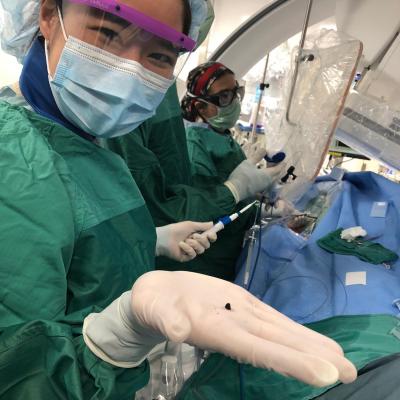The University Hospital has five dedicated IR angiography suites, including two combined CT-angiography suites and two angiography suites with cone-beam CT capability, as well as three Neurointerventional bi-plane angiography suites. The Frankel Cardiovascular Center has two dedicated IR angiography suites with cone-beam CT capability, one additional vascular and IR angiography suite with cone-beam CT, and one hybrid/angiography OR. The C. S. Mott Women and Children’s hospital has one dedicated IR bi-plane angiography suite.
The Ann Arbor Veteran’s Affairs Hospital, the largest in our state, has two state-of-the-art angiography suites and a dedicated procedural CT scanner.
Independent IR Residents (formerly known as IR Fellows) will perform the entire gamut of image guided minimally invasive procedures in a clinically-based VIR practice.
With one of the highest trainee to procedure ratios in the country, trainees will have the opportunity to function under graduated supervision, including pre-procedure evaluation of patients, various vascular and nonvascular procedures, consultation with clinicians, admission to the interventional radiology service, and post-procedure follow-up care. Trainees will be instructed in proper use of physiologic monitoring, noninvasive vascular imaging, antibiotics, narcotics, conscious sedation, and other drugs commonly used in VIR. Examples of vascular interventional procedures include infusion therapy, catheter-directed thrombolysis, mechanical thrombofragmentation, embolotherapy, angioplasty and related percutaneous recanalization procedures for arterial and venous occlusions, stent placement, filter insertion, foreign body removal, TIPS, thoracic endografting, percutaneous fenestration for aortic dissection, and central venous access. Examples of nonvascular procedures include percutaneous and transvenous biopsy, abscess drainage, biliary interventions (cholecystostomy, biliary drainage, stone extraction, dilation, choledochoscopy, and stenting), GI interventions (percutaneous gastrostomy, gastrojejunostomy, jejunostomy, cecostomy, and dilation), and genitourinary interventions (percutaneous nephrostomy, dilation, and stone extraction), and vertebroplasty.
Trainees are encouraged to participate in ongoing clinical and basic research projects.



